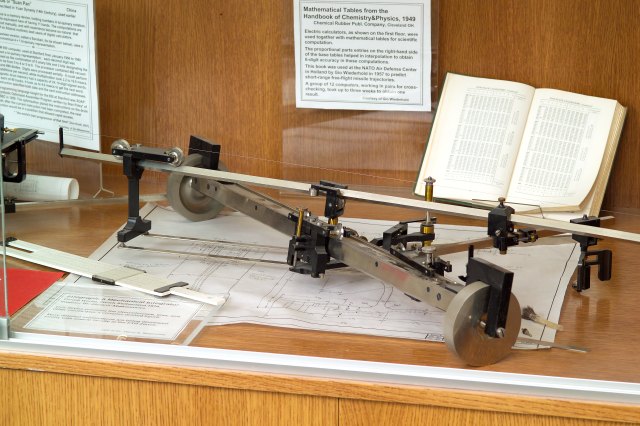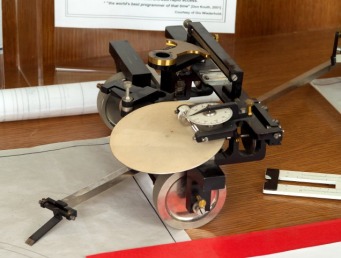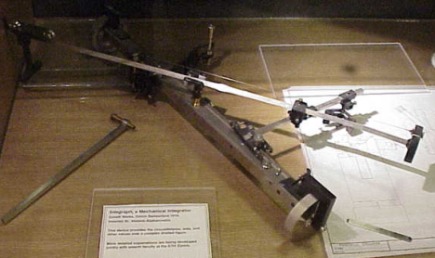 |
 |
 |
 |

|
 |
We show both analog (sliderule, planimeter) and digital devices (Abacus, mechanical calculators) here. They were often used in combination: analog for speed, digital for precision.
 |
 |
 |
 |

|
 |
We show both analog (sliderule, planimeter) and digital devices (Abacus, mechanical calculators) here. They were often used in combination: analog for speed, digital for precision.
The earliest digital computing device known is the Abacus. the Chinese
Abacus is largely unchanged since early records reaching back to ~500
B.C. The notation is bi-quinary: an upper deck selecting the 0-5 or
6-10 range, and the lower deck representing (in unary notation) 0-5 or
6-10. The beads are moved to add or subtract, and when all beads in a
deck are up a carry to the next position is made.
Multiplication and
division are carried py repetetive addition and subtraction, much like
the mechanical calculators shown on Floor 1.
Divison on an abacus was described
in Latin by Bishop Gerbert of Navarro, Spain, who later, in AD. 999,
become Pope Sylvester II.
The Russian version of an Abacus did not have the central bar, the
unit beads were colored light and the 5-beads were dark.
A Japanese Soroban, shown below, is more `efficient', using only one and four
beads, but requires different fingering. The Roman Abacus used a similar
configuration, somewhat matching the represenation by Roman numerals.
The IBM 650 computer of
1963 used the Japanese format form of bi-quinary [Console picture from
].
[Some of this information is due to Thomas B. Steel, jr., provided at
a lecture at the Cosmos club in 2004.]
 |  |
 |
In 1604 Blaise Pascal invented a mechanical calculator, the Pascaline.
We don't have one on display, but on the
first floor, we show an American successor, the Lightning
calculator.
In this display we do show a pocket version, a German
Comptator. Compatators were made with few changes from from 1920 to 1948.
Input entries are also made by using a stylus,
moving the bars on top down the desired amount. The result appears in the
counters below. A reset lever is on the left side.
(More Comptator images:
set for addition of
42,451.22. The result is visible, once the adding
slides are reset to the top:
after addition. Also a
larger images, front and
rear).
On the third floor we show a simple paper slide calculator for performing computation in hexa-decimal (base 16>.
For heavy-duty work, key-operated calculators were developed. Again,
a lever, now connected to the keys for one digit, moved one of
the counting wheels appropriatly.
Such manual (and successor electric calculators) are shown in a case on the first floor.
Several of the manufacturers (Marchant, Friden, a.o.) were located in
the East Bay area near San Francisco. Friden became an early manufacturer
of electronic calculators.
 |
A slide rule (see detail: Aristo
Slide rule, Germany, 1956) has graduations on logarithmic scales, so
that the analog catenation of two factors gives the product.
Illustrated in the display with the values, as 2 x 3 = 6.
Serial calculation is easy, and
trigonometric functions are also available.
With care 3-digit
accuracy can be obtained, although heroes on slide
rules would claim more, sometimes even 4 digits.
This calculator is essentially a slide rule as well, with the scales wrapped around two concentric cylinders. The spiral layout makes the effective length 120 inches, 10 times that of the linear slide rule shown above. Now 3- to 4-digit accuracy can be achieved. The brown barrel has fine markings on the bottom and top; it is equivalent to the slide on a linear sliderule. To compute, the barrel is moved initially to 1 at the bottom and one factor is set by matching the top cylinder to the top mark on the barrel. Then any second factor can be set by moving the barrel's bottom mark to a value on the bottom cylinder. The product can then be read off at the barrel's top mark.
 |
The oldest device on our exhibits.
More complex analog devices can perform integration.
 |
 |
These devices were built and sold by the Coradi Werke, Zuerich Switzerland. The Planimeter was invented in 1854 by Jakob Amsler-Laffon (1823-1912). Gift of Dr. Harry S. Newcomer.
Mechanical integratorss compute the area or circumference of a
drawn curve. Inegration takes place while the pointer at the end is moved
along the curve. The
resulting linear and angular motions are converted into a readout,
either a dial or a relative position of the device.
Vannevar Bush used such integrators as part of his Differential
Analyzers (1931, 1945) at M.I.T. We know Vannevar Bush mainly from
his concept of a Memex, published in 1945: an information desk with
windows, document input and output, sliders, hyperlinks, and storage.
In 1919 Alfred received an Honorary Doctorate from the
E.T.H. Zuerich.
The G. Coradi factory was purchased in 1960 by Alfred Amsler & Co.,
Schaffhausen, Switzerland. Alfred (1957-1939) was the son of Jacob
Amsler.
The Disc Planimeter provides the area of an arbitrary drafted closed figure. The device is rolled over the figure, holding the far point constant while moving the pointer along its circumference. The heavy rollers assure a straight motion for the x-axis. The large disk rotates proportional to the x-direction. The small wheel moves radially on the large disk proportional to the y-direction, its rotation provides dy. The total rotation of the wheel provides the integral, which is displayed on the counter. Its primary use was in computing the area of irregularly-shaped parcels of land.
We have not be3en able to work out the operation of the Integraph, although a brochure provided by Prof. Erismann tells us that it was very popular due to its simple operation. [information courtesy of Prof. Theodor Erisman, emeritus of the E.T.H.]
Shown in the rear of the case is book of logarithms and other functions. Use of such tables allowed much more precise calculations than a slide rule, but the process is still based on the analog concepts. Publisher: Chemical Rubber Publishing Company, 1949, Cleveland OH.
For scientific computation calculators were used together with the mathematical tables, as shown in the rear of this display. The proportional parts entries on the right-hand side of the base tables helped in interpolation to obtain 6-digit accuracy in these computations. This book was used at the SHAPE (later NATO) Air Defense Center in Holland by Gio Wiederhold in 1957 to predict short-range free-flight missile trajectories. A group of 12 computors, working in pairs for cross-checking, took up to three weeks to obtain one result.
An extensive collection of old mechanical computers is maintained by
Prof. Tim Bergin and
documented
at the Computing History Museum of the American University in
Washington DC.
A neat calculator web site with much information and some
interactive capabilities is
maintained by Erez Kaplan.
Another web site with beautiful photographs of its collection of
scientific instruments and calculators at
the Foundation Galileo Galilei, formerly a part of the
University of Pisa in Italy.
 |
 |
 |
 |

|